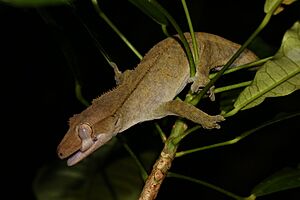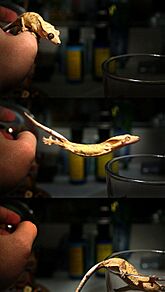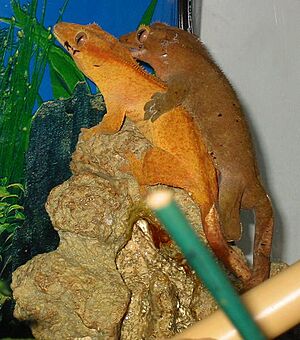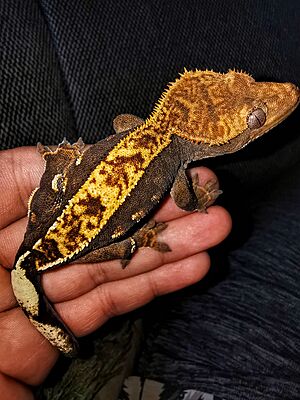Crested gecko facts for kids
Quick facts for kids Crested gecko |
|
|---|---|
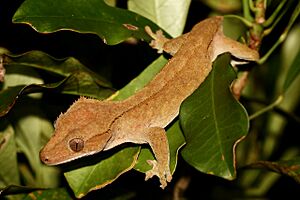 |
|
| Conservation status | |
| Scientific classification | |
| Genus: |
Correlophus
|
| Species: |
ciliatus
|
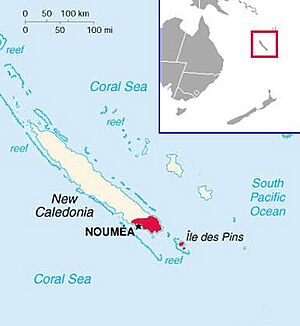 |
|
| Approximate distribution of the crested gecko | |
| Synonyms | |
|
|
The crested gecko or eyelash gecko (Correlophus ciliatus) is a type of gecko. It lives in southern New Caledonia, which is part of France. A French scientist named Alphonse Guichenot first described this gecko in 1866.
People thought these geckos were extinct for a long time. But they were found again in 1994 by Robert Seipp and his team. Now, scientists are thinking about protecting them. This is because they are rare, like other geckos from New Caledonia.
Contents
What is a Crested Gecko?
Why is it Called "Crested" or "Eyelash"?
The crested gecko gets its name from special skin flaps. These flaps look like eyelashes above its eyes. They continue as two rows of spines. These spines run from the eyes to the sides of its head. They also go down to the base of its tail.
The word ciliatus comes from Latin. It means "fringe" or "eyelashes." This perfectly describes the gecko's unique look.
Where Do Crested Geckos Live?
Crested geckos only live in South Province, New Caledonia. They are found in three separate areas. One group lives on the Isle of Pines and nearby small islands.
Two other groups live on the main island, Grande Terre. One group is near the Blue River Provincial Park, a protected area. The other is further north, close to Mount Dzumac. They like warm, tropical places.
How Do Crested Geckos Look?
Crested geckos are usually about 8 to 10 inches (20 to 25 cm) long. This includes their tail, which is about 4 to 6 inches (10 to 15 cm) long.
These geckos do not have eyelids. Instead, they have a clear scale over each eye. This scale keeps their eyes moist. They use their tongues to clean away any dirt.
Amazing Gecko Toes and Tail
Crested geckos have a special tail. It is called a semi-prehensile tail. This means they can use it to grab onto branches. It helps them climb and move around.
They can also drop their tail if a predator attacks them. This is called caudal autotomy. It helps them escape. Unlike some other lizards, crested geckos cannot grow their tails back. Many adult geckos in the wild do not have tails.
Their toes and the tip of their tail have tiny hairs. These hairs are called setae. Each seta has hundreds of even smaller hairs called spatulae. These tiny structures help the gecko stick to almost any surface. They can climb easily on glass or wood. They also have small claws to help them climb rougher spots.
Colors and Patterns
Crested geckos come in many natural colors. These include grey, brown, red, orange, and yellow. They can have different shades of these colors. In the wild, they have three main patterns. These are plain (pattern-less), white-fringed, and tiger.
Life in the Wild
Crested geckos mostly live in trees. They prefer the tops of the rainforests. They can jump long distances between branches. This helps them move to new places.
These geckos are nocturnal. This means they are active at night. During the day, they usually sleep in safe spots high in the trees. Crested geckos are omnivores. They eat fruit, nectar, pollen, and many different insects.
Threats to Wild Geckos
Crested geckos were once thought to be extinct. They are now being considered for special protection. The biggest danger to them is a tiny insect called the little fire ant. These ants attack the geckos in large groups. They also compete with the geckos for food.
Other dangers include wildfires that damage their homes. Rodents also hunt them. And introduced deer and pigs can harm their habitat.
How Crested Geckos Have Babies
We don't know much about how crested geckos have babies in the wild. Most of what we know comes from geckos kept as pets. Female geckos usually lay two eggs at a time. The eggs hatch about 60 to 150 days later.
A female gecko only needs to mate once. After that, she can lay two eggs every 4 to 6 weeks. This can continue for 8 to 10 months. After laying eggs, females in the wild take a break. This "cooling" cycle helps them get back their strength and nutrients. It usually happens in winter.
Crested geckos have two small calcium sacs in their mouths. Females need a lot of calcium to lay eggs. If a female doesn't get enough calcium, her sacs can become empty. This can make her shaky, tired, or lose her appetite. It can even be dangerous for her.
Newborn geckos usually don't eat right away. They rely on the food from their yolk sac. They start eating after they shed their skin for the first time.
Crested Geckos as Pets
It is now against the law to take wild crested geckos from New Caledonia. But before this rule, some geckos were brought out for breeding. From these geckos, many different breeding groups were started. This happened in both Europe and the United States.
Now, the crested gecko is a very popular pet. It is one of the most common geckos kept and bred worldwide. Only the leopard gecko is more popular.
Crested geckos can live a long time as pets. They have been known to live for 15 to 20 years or even more.



